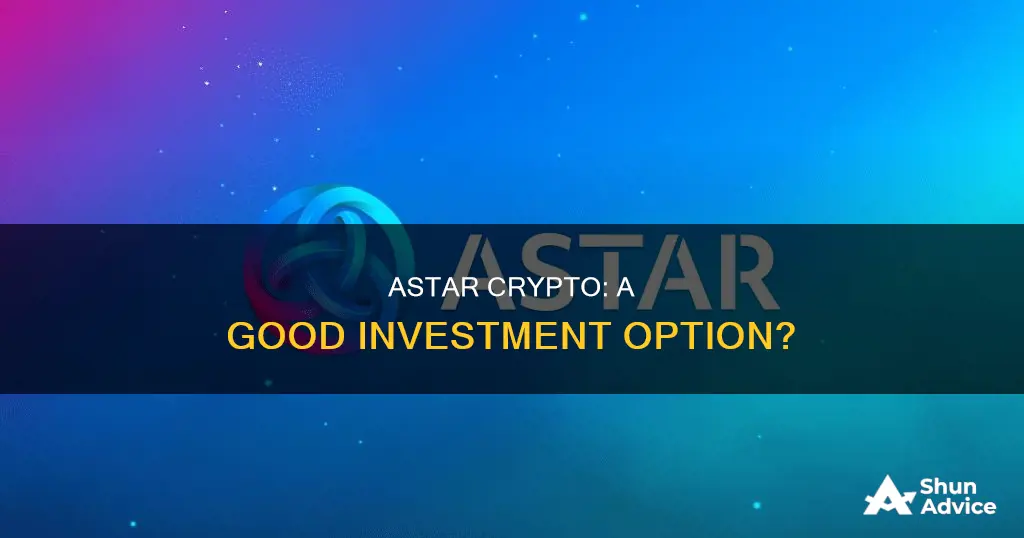
Astar (ASTR) is a cryptocurrency that has emerged as a prominent player in the blockchain space. It is a multi-chain smart contract platform built on Polkadot, acting as a decentralised application (dApp) hub, supporting Ethereum Virtual Machine (EVM), WebAssembly (Wasm), and layer-2 solutions like ZK Rollups. This allows developers to build dApps on Astar that can seamlessly interact with other blockchains, including Ethereum, Cosmos, and Bitcoin. The project’s goal is to become a multi-chain smart contract platform and support as many blockchains as possible. The network's native token, ASTR, operates as a utility token, a governance token and a staking token. Users can use ASTR to pay transaction fees, participate in the governance of the platform and stake tokens for consensus and receive rewards.
What You'll Learn

The Astar Network's interoperability and scalability
The Astar Network is a dApp hub on Polkadot that supports Ethereum, WebAssembly, and layer 2 solutions such as ZK Rollups. It aims to become a multi-chain smart contract platform that supports as many blockchains as possible.
Astar connects the Polkadot ecosystem with layer 1 blockchains like Ethereum and Cosmos. It was designed as a multi-chain Polkadot dApp hub with support for DeFi, NFTs, and DAOs, where developers can focus on application development.
The network is built on Parity Substrate, a web 3.0 blockchain-building platform. Networks like Astar that are built on Substrate benefit from features like upgradable blockchains, modular architecture, customizable block execution logic, and hot-swappable consensus.
Astar's interoperability is further enhanced by its support for different virtual machines. The network is built to support both EVM and WASM smart contracts, allowing them to coexist and communicate with each other.
Astar also utilizes the Cross-Consensus Message Format (XCM), which facilitates communication across different consensus systems. XCM enables functionalities like 'Remote Transfers', which allow control over accounts on other chains to facilitate asset movement, and 'Asset Teleportation', which involves burning assets on one chain and recreating them on another.
In addition to its interoperability features, Astar also focuses on scalability. The network operates on two layers: the first layer is built on the Substrate framework, while the second layer is built using the Optimistic Virtual Machine (OVM) to enhance scalability.
Astar's zkEVM technology also contributes to its scalability. zkEVM utilizes rollups to consolidate multiple transactions into a single block, improving Ethereum's scalability. The use of zero-knowledge proof (ZKP) technology in verifying transactions off-chain further enhances scalability and security.
Overall, the Astar Network's interoperability and scalability features create new opportunities for developers and users, contributing to the development of Web 3.0.
Ren Coin: A Smart Investment Decision?
You may want to see also

The ASTR token's utility and governance
The ASTR token is the native token of the Astar Network, serving multiple functions, including staking rewards, gas, and grants. It is integral to the network's growth and ability to attract developers and enterprises.
Utility and Governance
- Staking Rewards: ASTR tokens can be staked on dApps or at the network level, allowing users to earn rewards in the form of additional ASTR tokens. This incentivizes users to hold and stake the tokens, supporting the network's growth.
- Gas Fees: Tooling developed on the Astar Network allows developers to use ASTR for gas fees. In the Astar Substrate environment, 80% of the ASTR used for gas fees are burned, reducing the overall rate of increase in ASTR.
- Grants: The ASTR token is used for the dApp staking grants program, where builders who create projects or provide value to the network receive developer incentives. This program helps attract developers by offering financial support for their development activities.
- Governance: ASTR tokens also serve as governance tokens, allowing holders to participate in the governance of the platform by voting on or proposing referendums. This gives token holders a say in the direction and evolution of the project.
The Astar Network's innovative features, such as dApp staking, and its focus on interoperability and supporting multiple blockchains make it a unique and promising project in the blockchain space. The utility of the ASTR token within this ecosystem is essential to facilitating network activity, incentivizing developers, and supporting the network's growth.
Is XYO Crypto Worth Investing In?
You may want to see also

The project's backers and partners
The Astar Network has several backers and partners that support its development and growth. The project is backed by Binance Labs and Coinbase Ventures, two prominent names in the cryptocurrency and blockchain industry.
In addition to its backers, Astar has also established partnerships with various organisations to further its reach and capabilities. For example, Astar has partnered with Shibuya, a modern city in Tokyo known for its entrepreneurial spirit and vibrant culture, to support the ward's web3 initiatives. They are also collaborating with Deloitte Tohmatsu Group, a leading integrated marketing and innovation company, to transform the sports industry using Astar's zkEVM technology.
Astar has also formed a special partnership with Soneium, an Ethereum L2 chain developed by Sony Block Solutions Labs, a joint venture between the Sony Group and Startale. This partnership is expected to open up new opportunities for the Astar community and token holders.
Furthermore, Astar has integrated Chainlink's CCIP to enable a secure cross-chain ecosystem and has teamed up with Binance to create a unique staking mechanism. The network also receives support from its developers, Stake Technologies, which is headquartered in Singapore and operates from Japan.
Real Money Coin Pusher: Worth the Investment?
You may want to see also

The Build2Earn program for developers
The Astar Network's Build2Earn program is an innovative initiative that allows developers to earn a basic income while building out their products and communities. It provides financial incentives and technical support to Web3 developers, encouraging them to build on top of a secure, scalable, and interoperable blockchain.
Here's how it works:
- DApp Staking: Astar introduces the concept of dApp staking, which is similar to Proof-of-Stake (PoS) staking. dApp stakers, also known as nominators, can submit their Astar/Shiden tokens on dApps they want to support. This provides a motivation for developers to produce dApps on the Astar/Shiden network.
- Basic Income for Developers: Developers can earn a basic income if their dApp is nominated by the community. As the dApp gains popularity, more community members nominate it, allowing developers to receive a larger portion of the block reward.
- Symbiotic Connection: dApp staking allows for a symbiotic connection between dApp stakers (nominators), dApp creators, and dApp consumers. dApp stakers want the value of their tokens to grow, so they stake more tokens, reducing the number of tokens in circulation and increasing the token price. This market dynamic allows dApp stakers to acquire greater long-term value from their tokens while earning high annual percentage rates (APRs) by staking.
- Ecosystem Development: Users benefit from dApp staking as it encourages the development and improvement of the ecosystem. With developers able to profit while creating better dApps, the network attracts and retains more users, creating a network effect that aids the growth of the ecosystem and increases its long-term intrinsic value.
- AstarPass: AstarPass is a mapping between your Astar Native Address (Polkadot address) and your Astar EVM address (MetaMask address). It aims to attract more EVM dApp users to Astar and provide additional opportunities for users to join the Astar ecosystem. dApps can reward nominators with non-fungible tokens (NFTs), airdrops, and other incentives for staking their tokens on them.
- Incentivizing Developers: The Build2Earn program incentivizes developers by providing them with rewards in the form of ASTA/SDN tokens for using the network. These rewards come from dApp staking in the ecosystem and are distributed to developers who build and deploy dApps on Astar.
- Attracting SDN Holders: In return for the rewards, developers can attract SDN holders to stake their tokens on their dApp by offering a percentage of their rewards as incentives. For example, a dApp may offer to share 10% of the total accrued rewards with SDN holders who stake on their dApp.
The Build2Earn program is a unique feature of the Astar Network, encouraging the development and adoption of dApps on its platform. It provides a win-win scenario for developers, SDN holders, and users, fostering the growth of the entire Astar ecosystem.
Legitimate Bitcoin Investment: A Secure Guide to Crypto
You may want to see also

The risks and regulatory considerations
As with any cryptocurrency investment, there are risks and regulatory considerations to keep in mind when investing in Astar (ASTR). Here are some key points to consider:
- Volatility and Market Riskhighly volatile, and ASTR is no exception. The price of ASTR can fluctuate significantly, and investors need to be prepared for potential losses as well as gains. Market risk refers to the possibility that the overall cryptocurrency market may decline, affecting the value of ASTR.
- Regulatory Landscape: The regulatory landscape for cryptocurrencies is constantly evolving, and this poses potential challenges for Astar and the broader industry. Changes in regulations, tax policies, and government interventions can impact the viability and liquidity of cryptocurrency investments.
- Competition: Astar operates in a crowded interoperability space, with competitors like Cosmos and Avalanche. To maintain its competitive edge, Astar must continuously innovate and forge strategic partnerships. Failure to adapt or keep up with competitors could impact its long-term viability.
- Tokenomics: The tokenomics of ASTR, including inflation and distribution, can influence its long-term value. The supply and demand for ASTR tokens, as well as the overall market conditions, will determine its price and potential for growth or decline.
- Security and Hacking: Cryptocurrencies are susceptible to hacking and security breaches. Astar, as a relatively new cryptocurrency, may face increased scrutiny and potential vulnerabilities. Investors should carefully consider the security measures in place and the potential risks associated with storing and transacting ASTR tokens.
- Forks and Discontinuation: Cryptocurrencies can be affected by forks (updates or changes) or other discontinuation events. These events can impact the value and functionality of ASTR, and investors should stay informed about any upcoming changes or potential risks.
- Regulatory Compliance: Investing in cryptocurrencies may require adhering to regulatory compliance in different jurisdictions. Know Your Customer (KYC) processes, anti-money laundering regulations, and tax reporting requirements can vary across countries, and investors must ensure they comply with the relevant laws and regulations.
- Liquidity and Market Capitalization: Astar's market capitalization, or the total value of its circulating tokens, is a factor to consider. Lower market capitalization coins like ASTR may have higher growth potential but also carry greater risk. Investors should carefully assess the liquidity and trading volume of ASTR to make informed decisions.
- Centralization Risks: While Astar aims to be decentralized, it is important to consider the level of centralization in its governance and decision-making processes. The concentration of tokens in the hands of a few large investors or the influence of certain key players could impact the direction of the project and potentially affect the rights and interests of smaller token holders.
- Network and Technical Risks: Astar, as a blockchain network, relies on its technical infrastructure and consensus mechanisms. Any disruptions, bugs, or failures in the network could impact the functionality and value of ASTR tokens. Investors should consider the robustness and security of the underlying technology.
It is important for investors to conduct thorough due diligence and carefully consider these risks and regulatory considerations before investing in Astar (ASTR) or any other cryptocurrency. Diversification, risk management strategies, and staying informed about market developments are crucial for navigating the volatile and evolving landscape of cryptocurrency investments.
Matt Damon's Crypto Investments: What We Know So Far
You may want to see also
Frequently asked questions
Astar is a multi-chain smart contract platform built on Polkadot, acting as a decentralised application (dApp) hub. It supports the Ethereum Virtual Machine (EVM), WebAssembly (Wasm) and layer-2 solutions like ZK Rollups.
Astar's core strength is its ability to bridge different blockchains, creating a more unified ecosystem. Developers can use various virtual machines and layer-2 solutions to optimise their dApps for scalability and security. It also incentivises developers through its Build2Earn program, rewarding them with ASTR tokens.
The interoperability space is crowded with competitors like Cosmos and Avalanche. Astar must maintain its competitive edge through innovation and partnerships. The evolving regulatory landscape for cryptocurrencies also poses a challenge. Tokenomics, including inflation and distribution, can impact its long-term value.







